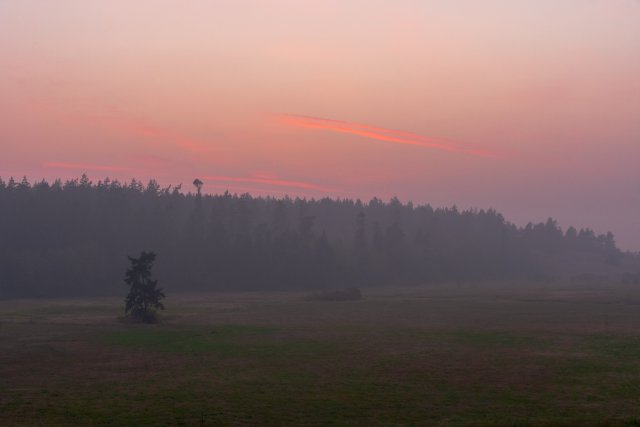EPA Partners with Tribes to Deploy Air Sensors in Communities

Published November 16, 2021
Air quality is a primary concern for many Pacific Northwest tribal communities, where smoke from wildfires and wood-heating devices can affect human health and is often present year-round. Particulate matter (PM) pollution from this smoke is especially harmful when it becomes trapped in wintertime inversion layers in the varied Pacific Northwest terrain. EPA is working to roll out air sensor loan programs in a variety of venues, including on tribal lands, to help people learn about air quality issues in their communities. This knowledge can better inform behavior changes to protect their health, such as adding indoor filter fans, sealing homes to reduce smoke intrusion, and limiting ambient air exposure during unhealthy PM pollution conditions.
Air sensor loan programs provide PurpleAir sensors that measure localized air quality data, which is then calculated as an Air Quality Index in real time and made publicly available on EPA’s Fire and Smoke Map. This added data brings value to remote, data sparse areas which may not have nearby regulatory monitors and where air quality may be heavily influenced by terrain.
EPA scientists are partnering with the Nez Perce Tribe, Heritage University (located on the Yakama Reservation), and the Institute of Tribal Environmental Professionals (ITEP) to increase the availability of low-cost air sensors for tribal community use. The goal of the partnership is to engage with and empower tribal communities to learn about air quality science, gain an understanding of particulate matter pollution and its health risks, and learn how to interpret air quality data.
The project team produced K-12 air quality curricula to be used for library programs, after school activities, classrooms, and by individuals; a QuickStart guide; a Resources Guide; and Air Qualtiy 101 trainings that can be shared. These resources are aimed at engaging citizen scientists through air quality monitoring. A lesson plan titled Is this Smoke Affecting Me? has been tailored to include regional and Tribal concerns and pollution sources. In preparation for wildfire season, the Nez Perce Tribe Air Quality Program (in partnership with EPA) launched their air sensor loan project at nine rural libraries featuring nine low-cost PurpleAir sensors in conjunction with EPA’s Air Quality Flag Program, a demonstration do-it-yourself box fan filter, and the newly developed resources. The sensors track air quality in real time, and the Air Quality Index associated with the local air pollution levels is publicly accessible online. Heritage University will be launching sensors at tribal schools and a cultural center this fall, and the ITEP recently placed sensors at two tribal consortiums in Alaska. The Nez Perce Tribe Air Quality Program considers this project a huge success so far.
“We are really honored and so thankful that you all reached out to us last fall. Synergy! This project has allowed us to take our library partnership deeper and really support communities across the Reservation to increase awareness and action around smoke. It’s one of the best things to come from 2020 in my book.” - Johna Boulafentis, Environmental Outreach Specialist, Nez Perce Tribe Air Quality Program
EPA scientists are also partnering with the Cherokee Nation of Oklahoma, Catawba Indian Nation, the Seminole Tribe of Florida, and other state and local partners to host an air sensor collocation shelter. These air sensor collocation shelters will be installed at regulatory air monitoring sites across the country. The structures provide a weather-protected space into which people can place their air sensors to collect data side-by-side with the regulatory agency grade monitor so the data can be compared. Communities can develop correction equations for their low-cost air sensors to make the sensor data more comparable to agency grade monitor data and use the sensors to do other studies or take measurements in the community. So far, six shelters have been delivered to the following locations: North Carolina Department of Environmental Quality in Raleigh, North Carolina; Orange County Environmental Protection Division in Orlando, Florida; Broward County Air Monitoring in Davie, Florida; Louisville, Kentucky; City of Jacksonville Environmental Quality Division, in Florida; and Catawba Indian Nation Environmental Services Department in Rock Hill, South Carolina. An additional 12 shelters will be delivered soon to communities in Oregon, Florida, South Carolina, New Jersey, California, Oklahoma, Michigan, and Minnesota.
Partnerships like these can be powerful ways to advance citizen science efforts that use innovative approaches to protect communities from health risks such as air pollution. A recent white paper developed by E-Enterprise Leadership Council Tribal members provides case studies about how tribes can use citizen science in environmental protection efforts. The paper highlighted several themes that can inform future citizen science efforts and partnerships with tribal communities. For example, data sovereignty is a concern of tribal communities, and questions about data collection, storage and sharing should be discussed early in projects. Tribes, as independent sovereign nations, ultimately have ownership over data they collect and can decide who can use the data and how it can be used. Sensitivity to traditional knowledge is important when partnering with tribes, and consideration of the cultural context of Tribal partners can enrich citizen science projects. Finally, the paper found that collaborations with agencies, non-governmental organizations, and academia can be key to conducting successful citizen science projects with tribes as these partnerships increase access to subject matter expertise and resources such as laboratories and specialized equipment.
To learn more about tribal citizen science projects and loan programs, visit EPA’s Air Sensor Loan Programs page. Visit EPA’s Smoke-ready Toolbox for Wildfires page to learn more about how to prepare for wildfire season.
